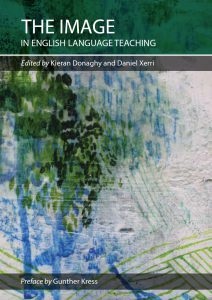The Image in English Language Teaching edited by Kieran Donaghy and Daniel Xerri
reviewed by Margarita Kosior, Greece
Born in Poland and based in Greece, Margarita Kosior is a materials writer and a tertiary educator teaching Language Teaching Methodology at the Bachelor's and Master's levels. Margarita is also a passionate storyteller, a teacher trainer and a frequent presenter at conferences.As an advocate for social justice, Margarita believes in spreading awareness of global issues through ELT.
E-mail: margaritakosior@gmail.com
The Image in English Language Teaching
Published by ELT Council
2017
Edited by Kieran Donaghy and Daniel Xerri
Free download from
www.teachingenglish.org.uk/sites/teacheng/files/

Making and communicating meaning involves much more than uttering words or writing them down. In fact, words may not even play a leading role in communication. When spoken, they are accompanied by or overshadowed by gestures, grimaces or movement; when written, words go with images, colour and layout. The existence of such a multitude of resources has not only transformed the way we make and communicate meaning in our daily lives, but has also had a profound influence on the way we teach and learn.
The Image in English Language Teaching, edited by Kieran Donaghy and Daniel Xerri, is a compilation of papers based on sessions delivered at the five editions of the Image Conference organised in the years 2013-17. The ultimate goal of the conference is to explore the possibilities presented to language teachers and learners by using existing moving and still images in their lessons, but also by getting their students involved in creating such images. There seems to be a general consensus that the bombardment of visual images in contemporary society has diminished our ability to focus clearly and for an extended period of time on a single issue. This is the reality in which our students grow up and develop the sense of self. In order to be able to make sense of this bombardment of images, we need to help learners develop the ability to slow down and we need to allow them the luxury of time and space they need to engage in deeper thinking. Only then will they be able to interpret the images they see and reflect on them.
To this end, educators and authors of the papers in the collection propose a variety of approaches and techniques. The collection is preceded by an introductory paper by Donaghy and Xerri in which he supports the view that ELT needs to embrace visual images and two new skills of viewing and representing need to be added to the curricula worldwide. By developing visual literacy of our learners, we will equip them with the tools necessary to function in a world of multimodal communication.
The authors of the papers which follow approach the theme from various angles. The first three papers, by Witcher, Goldstein and Clare, are devoted to the use and production of film in the language classroom. Authors of the next three papers: Wasilewska, Zakime, and Domínguez Romero and Bobkina, focus on the use of social media, mainly Instagram or Pinterest, and visual images (such as memes) in language education. In his paper, Fresacher unveils the power of images which surround us in our daily lives, such as product packaging or advertising, whereas Seburn argues that selecting images does not have to lie entirely with the teacher. In fact, he claims that asking students to select images related to the texts, and then to present them in class and explain how the image helped them understand the concepts from the text more fully, develops their autonomy as learners. Another group of authors, Papalazarou, Karastathi, Brzezinska and Pratt, present interesting approaches to using and creating art in the language classroom. Moving on, Dummett, Driver, Lewis, and Theuma explore the connection between the image and storytelling and explain how graphic novels, comics and cartoons can be used to the benefit of learners. Last but not least, Benévolo França claims that images of our classroom taken before, and after the lesson, but also while we are teaching, can reveal a lot of truth about the way in which we interact with our students and use our working space.
In general terms, the traditional group of four skills of reading, writing, listening and speaking need to be supplemented with the skills of viewing and representing. In other words, learners need to develop the ability to understand visual media and to communicate their ideas using visual means.
Overall, the book covers a wide range of issues related to visual literacy and it strikes a fine balance between theory, research findings and practical ideas. It provides sound theoretical background along with ready-to-use and easy-to-apply activities: a real time-saver for the teacher. The papers are written in a very approachable manner and each presents an interesting and unique angle when discussing the role of the image in contemporary education.

Please check the Creative Methodology for the Classroom course at Pilgrims website.


|